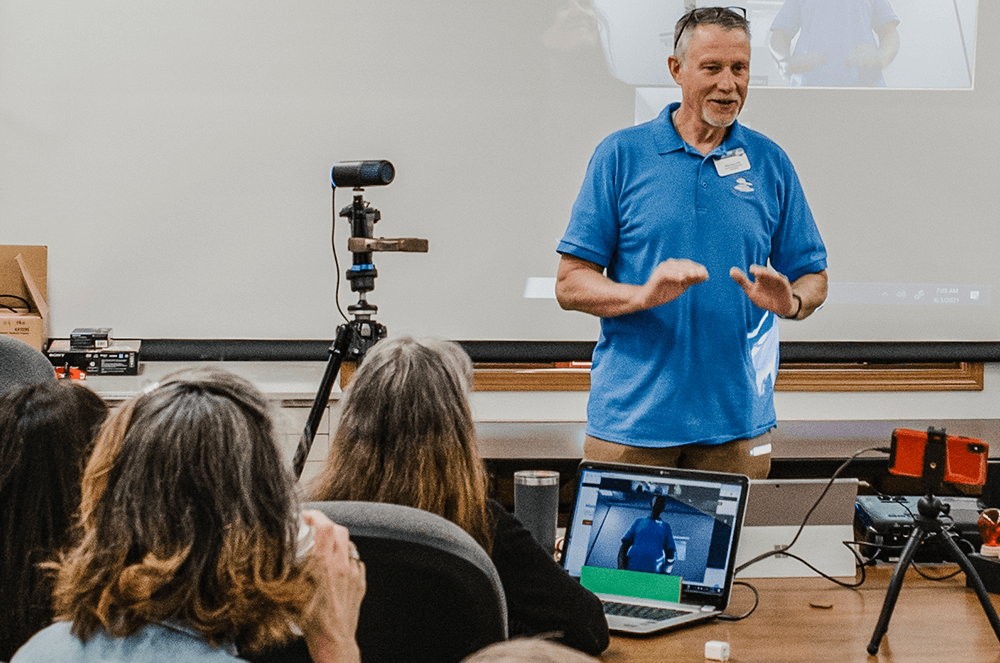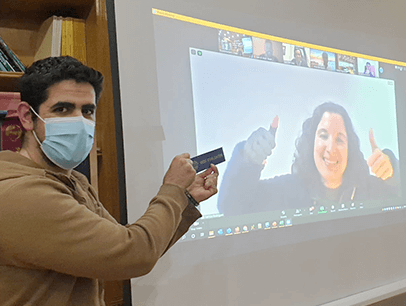 During hybrid meetings, both in-person and online attendees can see Cloud Peak Toastmaster Cody Wyatt and the timing lights.
During hybrid meetings, both in-person and online attendees can see Cloud Peak Toastmaster Cody Wyatt and the timing lights.As we emerge from the COVID cocoon, clubs have three options—go back to in-person meetings, stay fully online, or go hybrid, where you combine both methods. All have their merits, and you probably have experience by now in in-person and online meetings. Hybrid meetings offer other benefits and challenges. As you start to explore the hybrid option, there are some questions to consider.
Hear what author Bill Brown, DTM, has to say about his club experimenting with a hybrid format.
1 Why do you want to go hybrid? What is your objective?
There are a number of possible reasons. Perhaps you want to boost membership. World Headquarters gives us a target of 20 members. Some clubs are below that number. A hybrid meeting gives you the opportunity to go beyond your immediate location. In fact, you can bring people in from anywhere in the world, including those in your hometown who would rather attend from the comfort of their own home. This could be an advantage in recruiting.
During the Zoom meeting era, some clubs have already brought in members from out of town. One Nevada club has a member from Arizona and one from Japan. They don’t want to lose those members, so they will be going hybrid.
Another reason to go hybrid is to gain expertise in remote meetings. This style of meeting was already common in the corporate world prior to COVID, but it will become even more so as we go forward. This gives us a new skill area to develop.
If we find ourselves as one of those remote attendees in a corporate meeting, we need to be adept at communicating in this medium. If we are selling a product or idea, our persuasiveness is affected by our online performance. The same could be said if we are giving a status report. Both hybrid and online Toastmaster meetings help us develop that skill.
2 Are you willing to put in the effort to make a hybrid club happen?
Hybrid meetings increase the complexity of a Toastmaster meeting. You need the right room setup to enable the in-person attendees to see those online. And you need equipment to make it happen. You also need someone who is tech savvy enough to put that together each week. On top of that, you need to manage the meeting so that your online attendees feel included. And it requires a total club effort. Does your club have a setup that would work and people who would be willing to make it happen?
 Cloud Peak Toastmasters Club in Sheridan, Wyoming, uses affordable technology that works just as well as pricier options.
Cloud Peak Toastmasters Club in Sheridan, Wyoming, uses affordable technology that works just as well as pricier options.If these considerations sound doable for your club, then seriously explore a hybrid meeting. If not, then this style might not be for you.
3 What will attract outside members to join your club?
Just by announcing that you are now hybrid does not mean that Toastmasters from around the world are going to flock to your meeting. You might get many visitors, but what is going to make them stay and become members?
If I am looking to join a hybrid club, I personally have at least two objectives—to have opportunities to speak and to have members of the club who can give me strong feedback. I want rigorous evaluations. I may find several clubs that fit those criteria, but I will pick just one of them. Why should I pick you?
The question of going hybrid is an individual decision for each club.
All Toastmasters and guests have their own objectives. They are looking for the best option for them based on their personalized criteria. They may check out a number of clubs too. You are competing with those clubs for their membership. Why should they pick you? In other words, do you have a meeting that sells itself to virtual visitors?
While you don’t really need an answer to that question to go hybrid, I suggest that it is something that you might want to think about. It can push the club to get better, which is, of course, a good thing.
4 Do the members of your club want to go hybrid?
Let’s say that you have answered the above questions and you think that a hybrid format would be a good fit for your club. The next question is, do your club members agree? Are they behind the change?
This is a business decision, so you have to go through the club vote with a quorum. If a majority agree, then move ahead. Although, it may be a bit more complicated than that. I personally think that if the decision isn’t near unanimous, you run the risk of chasing off a large group of your members. And that would be counterproductive.
Before taking a vote, I suggest that you check with key people in your club. The tech-savvy folks need to be on board. They, after all, will bear the brunt of the effort.
In addition, each club has certain people who are the keeper of the keys, so to speak. Those members have perhaps been there since the club founding, and while not necessarily in leadership, have great influence over the direction of the club. Make sure that they are on board. They will help you sell the concept.
Finally, check with every club member to gauge their support level and answer any questions or concerns that they might have.
When you have done that, bring it up at a club meeting for discussion. If there are disagreements, work to keep it civil. And then, when you are ready, take your vote.
If your club does vote to switch to a hybrid format, your officers simply need to update the Addendum of Standard Club Options, which can be filled out online via Club Central or emailed to clubquality@toastmasters.org.
Hybrid meetings are a great way for many members to get the benefits from Toastmasters that they are looking for. And they are a great way for Toastmaster clubs to expand their reach and serve more people. The question of going hybrid is an individual decision for each club. You need to know what you want to achieve and what you will do to make it happen. And you’ll want to consider how a hybrid meeting affects various aspects of the meeting, and perhaps make adjustments. When you know that, you are well on your way.
Bill Brown, DTM is a speech delivery coach in Gillette, Wyoming. He is a member of Energy Capital Toastmasters in Gillette. Learn more at billbrownspeechcoach.com.
Related Articles

Online Meetings
Hybrid Harmony

Online Meetings
Technology for Hybrid Meetings

Communication



 Previous
Previous
 Previous Article
Previous Article